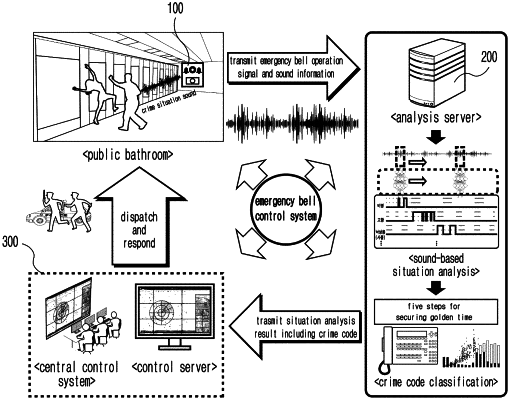| CPC G10L 25/51 (2013.01) [G08B 3/00 (2013.01); G08B 23/00 (2013.01); G08B 25/00 (2013.01); G10L 25/30 (2013.01)] | 6 Claims |

|
1. A system for controlling an emergency bell based on sound, the system comprising:
an emergency bell device installed in a crime area, gathering sound information generated in the crime area, detecting an emergency event from the gathered sound information, and generating an emergency bell operation signal;
an analysis server receiving, in real-time, the sound information from the emergency bell device if the emergency bell operation signal is received, classifying per-time key sound sources in the sound information, and providing a situation analysis result on whether a crime occurs using the classified per-time key sound sources; and
a control server receiving the situation analysis result and providing on-site dispatch information or situation response information to a security terminal in charge of the crime area based on the received situation analysis result, wherein the analysis server performs an artificial intelligence-based sound analysis algorithm that extracts an effective feature including a correlation in a time-frequency domain for the sound information having time series characteristics, classifies at least one key sound source based on the extracted effective feature using a convolutional neural network (CNN), and predicts the situation analysis result for the on-site situation using the classified key sound sources, wherein the artificial intelligence-based sound analysis algorithm includes:
a data gathering module gathering a number of sample sound sources for each crime situation and stores them as a dataset for training;
a training module pre-processing the sample sound sources, extracting an auditory characteristic, as a feature vector, from the pre-processed data, and generating and training a classifier for classifying the key sound sources for each crime situation using the extracted feature vector;
a situation analysis module pre-processing the sound information received from the emergency bell device to extract the feature vector and classifying at least one key sound source using the trained classifier for the extracted feature vector;
a prediction module predicting the situation analysis result for a crime situation derived based on the classified key sound sources; and
a code classification module classifying the situation analysis result predicted by the prediction module into a crime code of a preset security level, setting a different dispatch time, responding personnel, and situation response behavior information depending on the classified crime code, and providing the on-site dispatch information or the situation response information.
|